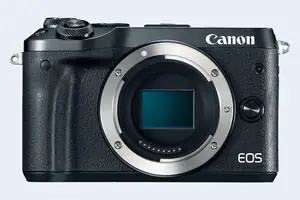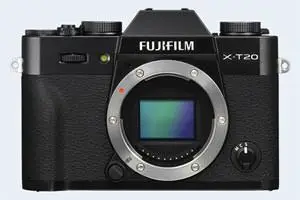Canon M6 vs Fujifilm X-T20
The Canon EOS M6 and the Fujifilm X-T20 are two digital cameras that were announced, respectively, in February 2017 and January 2017. Both the M6 and the X-T20 are mirrorless interchangeable lens cameras that are equipped with an APS-C sensor. Both cameras offer a resolution of 24 megapixels.
Below is an overview of the main specs of the two cameras as a starting point for the comparison.

Check M6 offers at
ebay.com

Check X-T20 offers at
ebay.com
Going beyond this snapshot of core features and characteristics, what are the differences between the Canon EOS M6 and the Fujifilm X-T20? Which one should you buy? Read on to find out how these two cameras compare with respect to their body size, their imaging sensors, their shooting features, their input-output connections, and their reception by expert reviewers.
Body comparison
An illustration of the physical size and weight of the Canon M6 and the Fujifilm X-T20 is provided in the side-by-side display below. The two cameras are presented according to their relative size. Three consecutive views from the front, the top, and the rear side are shown. All size dimensions are rounded to the nearest millimeter.
Both cameras are available in two different colors (black, silver).
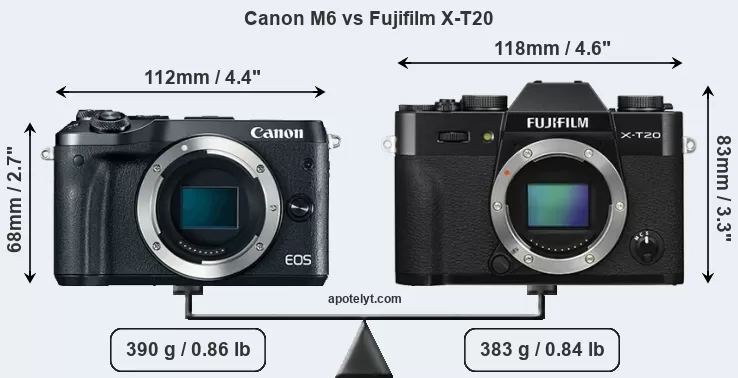

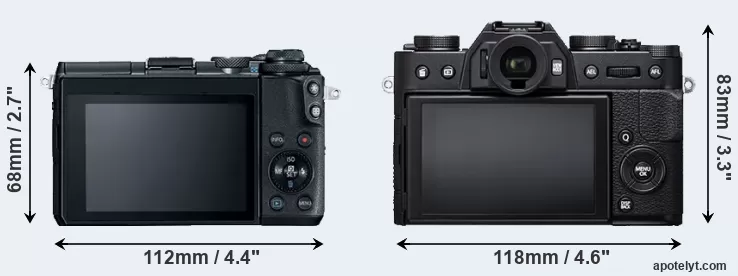
If the front view area (width x height) of the cameras is taken as an aggregate measure of their size, the Fujifilm X-T20 is notably larger (29 percent) than the Canon M6. However, the X-T20 is slightly lighter (2 percent) than the M6. In this context, it is worth noting that neither the M6 nor the X-T20 are weather-sealed.
The above size and weight comparisons are to some extent incomplete since they do not consider the interchangeable lenses that both of these cameras require. Hence, you might want to study and compare the specifications of available lenses in order to get the full picture of the size and weight of the two camera systems.
Concerning battery life, the M6 gets 295 shots out of its Canon LP-E17 battery, while the X-T20 can take 350 images on a single charge of its Fujifilm NP-W126S power pack. The power pack in the X-T20 can be charged via the USB port, which can be very convenient when travelling.
The adjacent table lists the principal physical characteristics of the two cameras alongside a wider set of alternatives. If you want to switch the focus of the display and review another camera pair, you can move across to the CAM-parator tool and choose from the broad selection of possible camera comparisons there.

| Camera Model |
Camera Width |
Camera Height |
Camera Depth |
Camera Weight |
Battery Life |
Weather Sealing |
Camera Launch |
Launch Price (USD) |
Street Price |
||
|---|---|---|---|---|---|---|---|---|---|---|---|
| 1. | Canon M6 | 112 mm | 68 mm | 45 mm | 390 g | 295 | n | Feb 2017 | 779 | ebay.com | |
| 2. | Fujifilm X-T20 | 118 mm | 83 mm | 41 mm | 383 g | 350 | n | Jan 2017 | 899 | ebay.com | |
| 3. | Canon 77D | 131 mm | 100 mm | 76 mm | 540 g | 600 | n | Feb 2017 | 899 | ebay.com | |
| 4. | Canon M3 | 111 mm | 68 mm | 44 mm | 366 g | 250 | n | Feb 2015 | 679 | ebay.com | |
| 5. | Canon M5 | 116 mm | 89 mm | 61 mm | 427 g | 295 | n | Sep 2016 | 979 | ebay.com | |
| 6. | Canon M6 Mark II | 120 mm | 70 mm | 49 mm | 408 g | 305 | n | Aug 2019 | 849 | ebay.com | |
| 7. | Canon M50 | 116 mm | 88 mm | 59 mm | 390 g | 235 | n | Feb 2018 | 779 | ebay.com | |
| 8. | Canon M100 | 108 mm | 67 mm | 35 mm | 302 g | 295 | n | Aug 2017 | 499 | ebay.com | |
| 9. | Canon SL2 | 122 mm | 93 mm | 70 mm | 453 g | 650 | n | Jun 2017 | 549 | ebay.com | |
| 10. | Canon T6i | 132 mm | 101 mm | 78 mm | 555 g | 440 | n | Feb 2015 | 749 | ebay.com | |
| 11. | Canon T6s | 132 mm | 101 mm | 78 mm | 565 g | 440 | n | Feb 2015 | 649 | ebay.com | |
| 12. | Fujifilm X-A5 | 117 mm | 68 mm | 40 mm | 361 g | 450 | n | Jan 2018 | 399 | ebay.com | |
| 13. | Fujifilm X-E3 | 121 mm | 74 mm | 43 mm | 337 g | 350 | n | Sep 2017 | 899 | ebay.com | |
| 14. | Fujifilm X-T10 | 118 mm | 83 mm | 41 mm | 381 g | 350 | n | May 2015 | 799 | ebay.com | |
| 15. | Fujifilm X-T30 | 118 mm | 83 mm | 47 mm | 383 g | 380 | n | Feb 2019 | 899 | ebay.com | |
| 16. | Fujifilm X-T100 | 121 mm | 83 mm | 47 mm | 448 g | 430 | n | May 2018 | 599 | ebay.com | |
| 17. | Nikon D5600 | 124 mm | 97 mm | 70 mm | 465 g | 970 | n | Nov 2016 | 699 | ebay.com | |
| Note: Measurements and pricing do not include easily detachable parts, such as add-on or interchangeable lenses or optional viewfinders. | |||||||||||
The price is, of course, an important factor in any camera decision. The manufacturer’s suggested retail prices give an idea on the placement of the camera in the maker’s lineup and the broader market. The M6 was launched at a somewhat lower price (by 13 percent) than the X-T20, which makes it more attractive for photographers on a tight budget. Normally, street prices remain initially close to the MSRP, but after a couple of months, the first discounts appear. Later in the product cycle and, in particular, when the replacement model is about to appear, further discounting and stock clearance sales often push the camera price considerably down.
Sensor comparison
The size of the sensor inside a digital camera is one of the key determinants of image quality. All other things equal, a large sensor will have larger individual pixel-units that offer better low-light sensitivity, wider dynamic range, and richer color-depth than smaller pixels in a sensor of the same technological generation. Further, a large sensor camera will give the photographer additional creative options when using shallow depth-of-field to isolate a subject from its background. On the downside, larger sensors tend to be associated with larger, more expensive camera bodies and lenses.
Both cameras under consideration feature an APS-C sensor, but their sensors differ slightly in size. The sensor area in the X-T20 is 11 percent bigger. As a result of these sensor size differences, the cameras have format factors, respectively, of 1.6 (M6) and 1.5. Both cameras have a native aspect ratio (sensor width to sensor height) of 3:2.
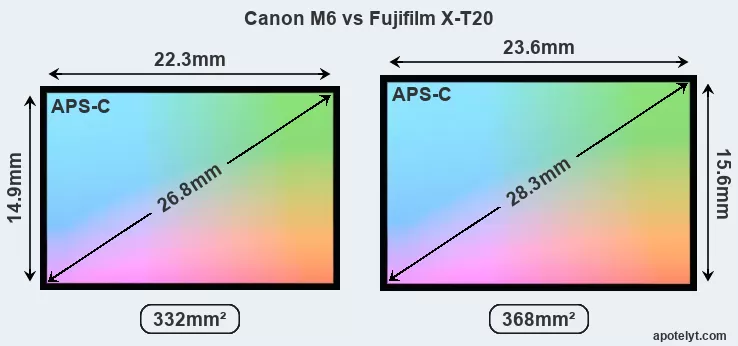
Even though the X-T20 has a larger sensor, both cameras offer the same resolution of 24 megapixels. This implies that the X-T20 has a lower pixel density and larger individual pixels (with a pixel pitch of 3.92μm versus 3.72μm for the M6), which gives it a potential advantage in terms of light gathering capacity. The two cameras were released in close succession, so that their sensors are from the same technological generation. Coming back to sensor resolution, it should be mentioned that the X-T20 has no anti-alias filter installed, so that it can capture all the detail its sensor resolves.
The Canon EOS M6 has a native sensitivity range from ISO 100 to ISO 25600. The corresponding ISO settings for the Fujifilm X-T20 are ISO 200 to ISO 12800, with the possibility to increase the ISO range to 100-51200.
Technology-wise, both cameras are equipped with CMOS (Complementary Metal–Oxide–Semiconductor) sensors. Like most digital cameras, the M6 uses a Bayer filter for capturing RGB colors on a square grid of photosensors. In contrast, the X-T20 employs a more randomized X-Trans layout of photosites, which according to Fujifilm helps to minimize moiré.
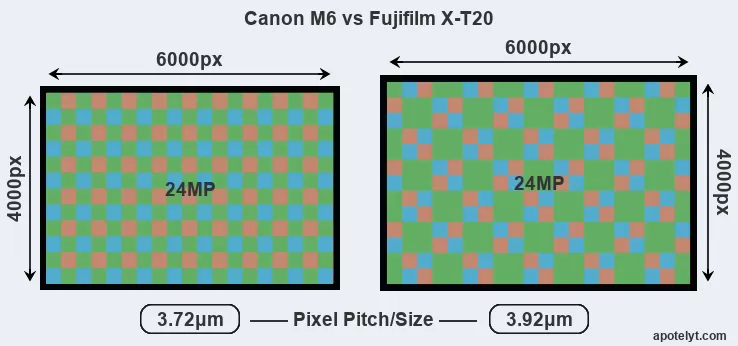
Since 2007, DXO Mark has published sensor performance measurements that have been derived using a consistent methodology. This service is based on lab testing and assigns an overall score to each camera sensor, as well as ratings for dynamic range ("DXO Landscape"), color depth ("DXO Portrait"), and low-light sensitivity ("DXO Sports"). The adjacent table reports on the physical sensor characteristics and the outcomes of the DXO sensor quality tests for a sample of comparator-cameras.

| Camera Model |
Sensor Class |
Resolution (MP) |
Horiz. Pixels |
Vert. Pixels |
Video Format |
DXO Portrait |
DXO Landscape |
DXO Sports |
DXO Overall |
||
|---|---|---|---|---|---|---|---|---|---|---|---|
| 1. | Canon M6 | APS-C | 24.0 | 6000 | 4000 | 1080/60p | 23.4 | 12.6 | 1317 | 78 | |
| 2. | Fujifilm X-T20 | APS-C | 24.0 | 6000 | 4000 | 4K/30p | 23.9 | 13.2 | 1704 | 81 | |
| 3. | Canon 77D | APS-C | 24.0 | 6000 | 4000 | 1080/60p | 23.6 | 13.3 | 971 | 78 | |
| 4. | Canon M3 | APS-C | 24.0 | 6000 | 4000 | 1080/30p | 22.8 | 11.8 | 1169 | 72 | |
| 5. | Canon M5 | APS-C | 24.0 | 6000 | 4000 | 1080/60p | 23.4 | 12.4 | 1262 | 77 | |
| 6. | Canon M6 Mark II | APS-C | 32.3 | 6960 | 4640 | 4K/30p | 24.0 | 13.5 | 1848 | 83 | |
| 7. | Canon M50 | APS-C | 24.0 | 6000 | 4000 | 4K/24p | 23.8 | 13.3 | 1684 | 81 | |
| 8. | Canon M100 | APS-C | 24.0 | 6000 | 4000 | 1080/60p | 23.5 | 12.9 | 1272 | 78 | |
| 9. | Canon SL2 | APS-C | 24.0 | 6000 | 4000 | 1080/60p | 23.6 | 13.4 | 1041 | 79 | |
| 10. | Canon T6i | APS-C | 24.0 | 6000 | 4000 | 1080/30p | 22.7 | 12.0 | 919 | 71 | |
| 11. | Canon T6s | APS-C | 24.0 | 6000 | 4000 | 1080/30p | 22.6 | 12.0 | 915 | 70 | |
| 12. | Fujifilm X-A5 | APS-C | 24.0 | 6000 | 4000 | 4K/15p | 24.0 | 13.3 | 1800 | 82 | |
| 13. | Fujifilm X-E3 | APS-C | 24.0 | 6000 | 4000 | 4K/30p | 23.9 | 13.3 | 1764 | 82 | |
| 14. | Fujifilm X-T10 | APS-C | 16.0 | 4896 | 3264 | 1080/60p | 23.7 | 12.9 | 1546 | 79 | |
| 15. | Fujifilm X-T30 | APS-C | 26.0 | 6240 | 4160 | 4K/30p | 24.1 | 13.5 | 1895 | 83 | |
| 16. | Fujifilm X-T100 | APS-C | 24.0 | 6000 | 4000 | 4K/15p | 24.0 | 13.4 | 1829 | 83 | |
| 17. | Nikon D5600 | APS-C | 24.0 | 6000 | 4000 | 1080/60p | 24.1 | 14.0 | 1306 | 84 | |
| Note: DXO values in italics represent estimates based on sensor size and age. | |||||||||||
Many modern cameras cannot only take still pictures, but also record videos. Both cameras under consideration are equipped with sensors that have a sufficiently high read-out speed for moving images, but the X-T20 provides a better video resolution than the M6. It can shoot movie footage at 4K/30p, while the Canon is limited to 1080/60p.
Feature comparison
Apart from body and sensor, cameras can and do differ across a range of features. For example, the X-T20 has an electronic viewfinder (2360k dots), which can be very helpful when shooting in bright sunlight. In contrast, the M6 relies on live view and the rear LCD for framing. That said, the M6 can be equipped with an optional viewfinder – the EVF-DC2. The table below summarizes some of the other core capabilities of the Canon M6 and Fujifilm X-T20 in connection with corresponding information for a sample of similar cameras.

| Camera Model |
Viewfinder (Type or 000 dots) |
Control Panel (yes/no) |
LCD Specifications (inch/000 dots) |
LCD Attach- ment |
Touch Screen (yes/no) |
Max Shutter Speed * |
Max Shutter Flaps * |
Built-in Flash (yes/no) |
Built-in Image Stab |
||
|---|---|---|---|---|---|---|---|---|---|---|---|
| 1. | Canon M6 | optional | n | 3.0 / 1040 | tilting | Y | 1/4000s | 9.0/s | Y | n | |
| 2. | Fujifilm X-T20 | 2360 | n | 3.0 / 1040 | tilting | Y | 1/4000s | 8.0/s | Y | n | |
| 3. | Canon 77D | optical | Y | 3.0 / 1040 | swivel | Y | 1/4000s | 6.0/s | Y | n | |
| 4. | Canon M3 | optional | n | 3.0 / 1040 | tilting | Y | 1/4000s | 4.2/s | Y | n | |
| 5. | Canon M5 | 2360 | n | 3.2 / 1620 | tilting | Y | 1/4000s | 9.0/s | Y | n | |
| 6. | Canon M6 Mark II | optional | n | 3.0 / 1040 | tilting | Y | 1/4000s | 14.0/s | Y | n | |
| 7. | Canon M50 | 2360 | n | 3.0 / 1040 | swivel | Y | 1/4000s | 10.0/s | Y | n | |
| 8. | Canon M100 | none | n | 3.0 / 1040 | tilting | Y | 1/4000s | 6.1/s | Y | n | |
| 9. | Canon SL2 | optical | n | 3.0 / 1040 | swivel | Y | 1/4000s | 5.0/s | Y | n | |
| 10. | Canon T6i | optical | n | 3.0 / 1040 | swivel | Y | 1/4000s | 5.0/s | Y | n | |
| 11. | Canon T6s | optical | Y | 3.0 / 1040 | swivel | Y | 1/4000s | 5.0/s | Y | n | |
| 12. | Fujifilm X-A5 | none | n | 3.0 / 1040 | tilting | Y | 1/4000s | 6.0/s | Y | n | |
| 13. | Fujifilm X-E3 | 2360 | n | 3.0 / 1040 | fixed | Y | 1/4000s | 8.0/s | n | n | |
| 14. | Fujifilm X-T10 | 2360 | n | 3.0 / 920 | tilting | n | 1/4000s | 8.0/s | Y | n | |
| 15. | Fujifilm X-T30 | 2360 | n | 3.0 / 1040 | tilting | Y | 1/4000s | 8.0/s | Y | n | |
| 16. | Fujifilm X-T100 | 2360 | n | 3.0 / 1040 | swivel | Y | 1/4000s | 6.0/s | Y | n | |
| 17. | Nikon D5600 | optical | n | 3.2 / 1037 | swivel | Y | 1/4000s | 5.0/s | Y | n | |
| Note: *) Information refers to the mechanical shutter, unless the camera only has an electronic one. | |||||||||||
The reported shutter speed information refers to the use of the mechanical shutter. Yet, some cameras only have an electronic shutter, while others have an electronic shutter in addition to a mechanical one. In fact, the X-T20 is one of those camera that have an additional electronic shutter, which makes completely silent shooting possible. However, this mode is less suitable for photographing moving objects (risk of rolling shutter) or shooting under artificial light sources (risk of flickering).
The Canon M6 and the Fujifilm X-T20 both have an intervalometer built-in. This enables the photographer to capture time lapse sequences, such as flower blooming, a sunset or moon rise, without purchasing an external camera trigger and related software.
Concerning the storage of imaging data, both the M6 and the X-T20 write their files to SDXC cards. Both cameras can use UHS-I cards, which provide for Ultra High Speed data transfer of up to 104 MB/s.
Connectivity comparison
For some imaging applications, the extent to which a camera can communicate with its environment can be an important aspect in the camera decision process. The table below provides an overview of the connectivity of the Canon EOS M6 and Fujifilm X-T20 and, in particular, the interfaces the cameras (and selected comparators) provide for accessory control and data transfer.

| Camera Model |
Hotshoe Port |
Internal Mic / Speaker |
Microphone Port |
Headphone Port |
HDMI Port |
USB Port |
WiFi Support |
NFC Support |
Bluetooth Support |
||
|---|---|---|---|---|---|---|---|---|---|---|---|
| 1. | Canon M6 | Y | stereo / mono | Y | - | mini | 2.0 | Y | Y | Y | |
| 2. | Fujifilm X-T20 | Y | stereo / mono | Y | - | micro | 2.0 | Y | - | - | |
| 3. | Canon 77D | Y | stereo / mono | Y | - | mini | 2.0 | Y | Y | Y | |
| 4. | Canon M3 | Y | stereo / mono | Y | - | mini | 2.0 | Y | Y | - | |
| 5. | Canon M5 | Y | stereo / mono | Y | - | mini | 2.0 | Y | Y | Y | |
| 6. | Canon M6 Mark II | Y | stereo / mono | Y | - | micro | 2.0 | Y | - | Y | |
| 7. | Canon M50 | Y | stereo / mono | Y | - | micro | 2.0 | Y | - | Y | |
| 8. | Canon M100 | - | stereo / mono | - | - | micro | 2.0 | Y | Y | Y | |
| 9. | Canon SL2 | Y | stereo / mono | Y | - | mini | 2.0 | Y | Y | Y | |
| 10. | Canon T6i | Y | stereo / mono | Y | - | mini | 2.0 | Y | Y | - | |
| 11. | Canon T6s | Y | stereo / mono | Y | - | mini | 2.0 | Y | Y | - | |
| 12. | Fujifilm X-A5 | Y | stereo / mono | Y | - | micro | 2.0 | Y | - | Y | |
| 13. | Fujifilm X-E3 | Y | stereo / mono | Y | - | micro | 2.0 | Y | - | Y | |
| 14. | Fujifilm X-T10 | Y | stereo / mono | Y | - | micro | 2.0 | Y | - | - | |
| 15. | Fujifilm X-T30 | Y | stereo / mono | Y | - | micro | 3.1 | Y | - | Y | |
| 16. | Fujifilm X-T100 | Y | stereo / mono | Y | - | micro | 2.0 | Y | - | Y | |
| 17. | Nikon D5600 | Y | stereo / mono | Y | - | mini | 2.0 | Y | Y | Y |
Both the M6 and the X-T20 have been discontinued, but can regularly be found used on ebay. The X-T20 was replaced by the Fujifilm X-T100, while the M6 was followed by the Canon M6 Mark II. Further information on the features and operation of the M6 and X-T20 can be found, respectively, in the Canon M6 Manual (free pdf) or the online Fujifilm X-T20 Manual.
Review summary
So what conclusions can be drawn? Which of the two cameras – the Canon M6 or the Fujifilm X-T20 – has the upper hand? Is one clearly better than the other? A synthesis of the relative strong points of each of the models is listed below.

Reasons to prefer the Canon EOS M6:
- Better moiré control: Has an anti-alias filter to avoid artificial patterns to appear in images.
- More selfie-friendly: Has an articulated screen that can be turned to be front-facing.
- Faster burst: Shoots at higher frequency (9 vs 8 flaps/sec) to capture the decisive moment.
- More compact: Is smaller (112x68mm vs 118x83mm) and thus needs less room in the bag.
- Easier device pairing: Supports NFC for fast wireless image transfer over short distances.
- Easier wireless transfer: Supports Bluetooth for image sharing without cables.
- More affordable: Was introduced into a lower priced segment (13 percent cheaper at launch).

Advantages of the Fujifilm X-T20:
- Maximized detail: Lacks an anti-alias filter to exploit the sensor's full resolution potential.
- Better video: Provides higher definition movie capture (4K/30p vs 1080/60p).
- Easier framing: Has an electronic viewfinder for image composition and settings control.
- Less disturbing: Has an electronic shutter option for completely silent shooting.
- Longer lasting: Gets more shots (350 versus 295) out of a single battery charge.
- Easier travel charging: Can be conveniently charged via its USB port.
If the count of relative strengths (bullet points above) is taken as a measure, the M6 comes out slightly ahead of the X-T20 (7 : 6 points). However, the pertinence of the various camera strengths will differ across photographers, so that you might want to weigh individual camera traits according to their importance for your own imaging needs before making a camera decision. A professional wildlife photographer will view the differences between cameras in a way that diverges from the perspective of a family photog, and a person interested in architecture has distinct needs from a sports shooter. Hence, the decision which camera is best and worth buying is often a very personal one.
How about other alternatives? Do the specifications of the Canon M6 and the Fujifilm X-T20 place the cameras among the top in their class? Find out in the latest Best Mirrorless Interchangeable Lens Camera listing whether the two cameras rank among the cream of the crop.
In any case, while the comparison of technical specifications can provide a useful overview of the capabilities of different cameras, it remains partial and cannot reveal, for example, the shooting experience and imaging performance when actually working with the M6 or the X-T20. User reviews, such as those found at amazon, can sometimes inform about these issues, but such feedback is often incomplete, inconsistent, and biased.
Expert reviews
This is where reviews by experts come in. The table below provides a synthesis of the camera assessments of some of the best known photo-gear review sites (amateurphotographer [AP], cameralabs [CL], digitalcameraworld [DCW], dpreview [DPR], ephotozine [EPZ], photographyblog [PB]). As can be seen, the professional reviewers agree in many cases on the quality of different cameras, but sometimes their assessments diverge, reinforcing the earlier point that a camera decision is often a very personal choice.

| Camera Model |
AP score |
CL score |
DCW score |
DPR score |
EPZ score |
PB score |
Camera Launch |
Launch Price (USD) |
Street Price |
||
|---|---|---|---|---|---|---|---|---|---|---|---|
| 1. | Canon M6 | .. | .. | .. | 80/100 | 4/5 | 4/5 | Feb 2017 | 779 | ebay.com | |
| 2. | Fujifilm X-T20 | 5/5 | + + | 5/5 | 82/100 | 5/5 | 4.5/5 | Jan 2017 | 899 | ebay.com | |
| 3. | Canon 77D | 4.5/5 | .. | 4/5 | 82/100 | 4.5/5 | 4/5 | Feb 2017 | 899 | ebay.com | |
| 4. | Canon M3 | 4/5 | o | .. | 75/100 | 4.5/5 | 4/5 | Feb 2015 | 679 | ebay.com | |
| 5. | Canon M5 | 4/5 | + | 4/5 | 82/100 | 4/5 | 4/5 | Sep 2016 | 979 | ebay.com | |
| 6. | Canon M6 Mark II | .. | + | 4.5/5 | 85/100 | 4/5 | 4/5 | Aug 2019 | 849 | ebay.com | |
| 7. | Canon M50 | .. | + | 4/5 | 79/100 | .. | 3.5/5 | Feb 2018 | 779 | ebay.com | |
| 8. | Canon M100 | 3/5 | + | .. | .. | 4/5 | 3.5/5 | Aug 2017 | 499 | ebay.com | |
| 9. | Canon SL2 | 4/5 | + + | 4/5 | 78/100 | 4.5/5 | 4.5/5 | Jun 2017 | 549 | ebay.com | |
| 10. | Canon T6i | 5/5 | .. | .. | 75/100 | 4.5/5 | 4.5/5 | Feb 2015 | 749 | ebay.com | |
| 11. | Canon T6s | 5/5 | + | .. | 77/100 | 4.5/5 | 4.5/5 | Feb 2015 | 649 | ebay.com | |
| 12. | Fujifilm X-A5 | .. | + | 4.1/5 | .. | 4/5 | 3.5/5 | Jan 2018 | 399 | ebay.com | |
| 13. | Fujifilm X-E3 | 4.5/5 | + | 4.5/5 | 84/100 | 4.5/5 | 4.5/5 | Sep 2017 | 899 | ebay.com | |
| 14. | Fujifilm X-T10 | 4.5/5 | + + | .. | 80/100 | 5/5 | 5/5 | May 2015 | 799 | ebay.com | |
| 15. | Fujifilm X-T30 | 5/5 | + + | 5/5 | 84/100 | 4.5/5 | 4.5/5 | Feb 2019 | 899 | ebay.com | |
| 16. | Fujifilm X-T100 | 4/5 | + | 4.5/5 | 79/100 | 4/5 | 4.5/5 | May 2018 | 599 | ebay.com | |
| 17. | Nikon D5600 | 4/5 | .. | 4/5 | 79/100 | 4.5/5 | 4/5 | Nov 2016 | 699 | ebay.com | |
| Note: (+ +) highly recommended; (+) recommended; (o) reviewed; (..) not available. | |||||||||||
The above review scores should be interpreted with care, though. The ratings are only valid when referring to cameras in the same category and of the same age. Thus, a score needs to be put into the context of the launch date and the launch price of the camera, and rating-comparisons among cameras that span long time periods or concern very differently equipped models make little sense. Also, kindly note that some of the listed sites have over time developped their review approaches and their reporting style.

Check M6 offers at
ebay.com

Check X-T20 offers at
ebay.com
Other camera comparisons
Did this review help to inform your camera decision process? In case you are interested in seeing how other cameras pair up, just make your choice using the following search menu. Alternatively, you can follow any of the listed hyperlinks for comparisons that others found interesting.
- Canon 1D Mark IV vs Fujifilm X-T20
- Canon 1D X Mark III vs Canon M6
- Canon 60D vs Canon M6
- Canon M6 vs Fujifilm GFX 50R
- Canon M6 vs Nikon D40X
- Canon M6 vs Nikon D800E
- Canon M6 vs Sony ZV-1
- Canon SX530 vs Fujifilm X-T20
- Fujifilm X-T20 vs Leica V-LUX 4
- Fujifilm X-T20 vs Olympus E-M5
- Fujifilm X-T20 vs Panasonic G85
- Fujifilm X-T20 vs Sony NEX-F3
Specifications: Canon M6 vs Fujifilm X-T20
Below is a side-by-side comparison of the specs of the two cameras to facilitate a quick review of their differences and common features.
| Camera Model | Canon M6 | Fujifilm X-T20 |
|---|---|---|
| Camera Type | Mirrorless system camera | Mirrorless system camera |
| Camera Lens | Canon EF-M mount lenses | Fujifilm X mount lenses |
| Launch Date | February 2017 | January 2017 |
| Launch Price | USD 779 | USD 899 |
| Sensor Specs | Canon M6 | Fujifilm X-T20 |
| Sensor Technology | CMOS | CMOS |
| Sensor Format | APS-C Sensor | APS-C Sensor |
| Sensor Size | 22.3 x 14.9 mm | 23.6 x 15.6 mm |
| Sensor Area | 332.27 mm2 | 368.16 mm2 |
| Sensor Diagonal | 26.8 mm | 28.3 mm |
| Crop Factor | 1.6x | 1.5x |
| Sensor Resolution | 24 Megapixels | 24 Megapixels |
| Image Resolution | 6000 x 4000 pixels | 6000 x 4000 pixels |
| Pixel Pitch | 3.72 μm | 3.92 μm |
| Pixel Density | 7.22 MP/cm2 | 6.52 MP/cm2 |
| Moiré control | Anti-Alias filter | no AA filter |
| Movie Capability | 1080/60p Video | 4K/30p Video |
| ISO Setting | 100 - 25,600 ISO | 200 - 12,800 ISO |
| ISO Boost | no Enhancement | 100 - 51,200 ISO |
| Image Processor | DIGIC 7 | X-Processor Pro2 |
| DXO Sensor Quality (score) | 78 | .. |
| DXO Color Depth (bits) | 23.4 | .. |
| DXO Dynamic Range (EV) | 12.6 | .. |
| DXO Low Light (ISO) | 1317 | .. |
| Screen Specs | Canon M6 | Fujifilm X-T20 |
| Viewfinder Type | Viewfinder optional | Electronic viewfinder |
| Viewfinder Field of View | 100% | |
| Viewfinder Magnification | 0.62x | |
| Viewfinder Resolution | 2360k dots | |
| LCD Framing | Live View | Live View |
| Rear LCD Size | 3.0inch | 3.0inch |
| LCD Resolution | 1040k dots | 1040k dots |
| LCD Attachment | Tilting screen | Tilting screen |
| Touch Input | Touchscreen | Touchscreen |
| Shooting Specs | Canon M6 | Fujifilm X-T20 |
| Focus System | On-Sensor Phase-detect | On-Sensor Phase-detect |
| Manual Focusing Aid | Focus Peaking | Focus Peaking |
| Max Shutter Speed (mechanical) | 1/4000s | 1/4000s |
| Continuous Shooting | 9 shutter flaps/s | 8 shutter flaps/s |
| Electronic Shutter | no E-Shutter | up to 1/32000s |
| Time-Lapse Photography | Intervalometer built-in | Intervalometer built-in |
| Fill Flash | Built-in Flash | Built-in Flash |
| Storage Medium | SDXC cards | SDXC cards |
| Single or Dual Card Slots | Single card slot | Single card slot |
| UHS card support | UHS-I | UHS-I |
| Connectivity Specs | Canon M6 | Fujifilm X-T20 |
| External Flash | Hotshoe | Hotshoe |
| USB Connector | USB 2.0 | USB 2.0 |
| HDMI Port | mini HDMI | micro HDMI |
| Microphone Port | External MIC port | External MIC port |
| Wifi Support | Wifi built-in | Wifi built-in |
| Near-Field Communication | NFC built-in | no NFC |
| Bluetooth Support | Bluetooth built-in | no Bluetooth |
| Body Specs | Canon M6 | Fujifilm X-T20 |
| Battery Type | Canon LP-E17 | Fujifilm NP-W126S |
| Battery Life (CIPA) | 295 shots per charge | 350 shots per charge |
| In-Camera Charging | no USB charging | USB charging |
| Body Dimensions |
112 x 68 x 45 mm (4.4 x 2.7 x 1.8 in) |
118 x 83 x 41 mm (4.6 x 3.3 x 1.6 in) |
| Camera Weight | 390 g (13.8 oz) | 383 g (13.5 oz) |

Check M6 offers at
ebay.com

Check X-T20 offers at
ebay.com
Did you notice an error on this page? If so, please get in touch, so that we can correct the information.
